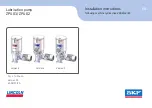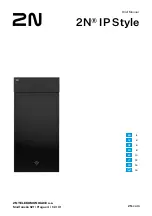
Discrete Transfer Commands
11
3.0
Discrete Transfer Commands
The PLC controller uses discrete write and discrete read commands to send and receive data from the Remote I/O
Interface. The PLC controller and Remote I/O Interface share a quarter rack of slot space, resulting in two 16-bit
words for the output image table (used to write commands to the indicator) and two 16-bit words for the input
image table (used to read data from the indicator).
3.1
Output Image Table Format
The PLC places two 16-bit words in the PLC output image table which are read by the Remote I/O Interface
node adapter. A discrete write command is performed when the PLC controller writes data to the output image
table. The Remote I/O Interface reads the contents of the output image table, translates the command to a form
that can be used by the indicator, and sends the command to the indicator.
The format of the output image table is shown in Table 3-1.
where:
v00–v15
16-bit signed integer value
R
Reserved
sss
Status data format
w
Weight format
bbb
Bit shift
cccc cccc
Command number
These fields are described below:
Value
Word 0 of the output image table is used for passing
value data on certain commands. This field should be
used only when block transfer is disabled. For
example, to enter a tare value, use word 0 to specify
the tare value; the Enter Tare command number (44) is
specified in bits 00 through 07 of word 1.
Values entered in this field are treated as 16-bit signed
integers. Possible values range from –32,768 to
32,767.
Status Data Format
The status data format bits specify the format of status
data returned to the PLC.
000
Remote function status data
001
Batch function status data (valid only for
Command 42, Batch Status)
010–111
Not defined
The IQ plus 510/710 indicators currently support only
remote function status data (000). Remote function
status data bits are described in Section 3.2.
Weight Format
Specifies the format of the weight data returned to the
PLC controller:
0
16-bit signed integer (negative values are formatted
as 2’s complement)
1
20-bit unsigned integer
The 16-bit signed integer format should be used when
the returned weight value is expected to be less than
32,767 (or 1,048,575, if using 5-bit bit shifting). This
format allows the PLC controller to make a direct
conversion of the value.
The 20-bit unsigned integer format is provided for
large numbers requiring greater precision than the
16-bit format can provide. This format can be used for
values up to 1 048 575 (or 16 777 215, if using 4-bit
bit shifting). The 20-bit format requires the PLC
program to piece together the additional four bits from
w o r d 0 i n t h e i n p u t i m a g e t a b l e ( s e e P L C
programming example in Section 5.2 on page 30).
Bit Shift
The bit shift field specifies how many digits the
weight value is to be shifted to the right before it is
returned in the input image table. Bit shifting
(discarding of the least significant digits) is done only
if required. Bit shift field values are shown in
Table 3-2 on page 12.
Bit
15
14
13
12
11
10
9
8
7
6
5
4
3
2
1
0
Word 0
v15
v14
v13
v12
v11
v10
v09
v08
v07
v06
v05
v04
v03
v02
v01
v00
Word 1
R
s
s
s
w
b
b
b
c
c
c
c
c
c
c
c
Table 3-1. Output Image Table Format
DISCONTINUED
















































